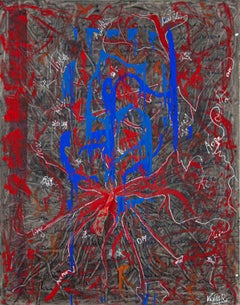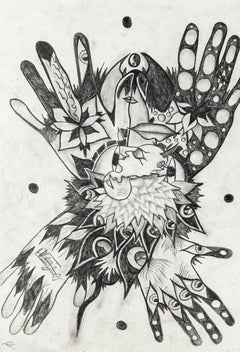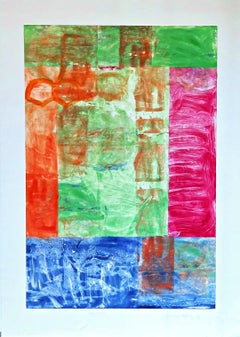Valerio Romagnoli Prints and Multiples
to
1
1
1
Overall Width
to
Overall Height
to
1
3
1,174
925
886
814
1
1
2
2
2
Artist: Valerio Romagnoli
Composition - Mixed media on canvas by Valerio Romagnoli - 2000s
By Valerio Romagnoli
Located in Roma, IT
Abstract composition is an original contemporary artwork realized in the 2000s by Valerio Romagnoli.
Mixed media on canvas (oil painting and collage on canvas).
Hand signed on the ...
Category
Early 2000s Contemporary Valerio Romagnoli Prints and Multiples
Materials
Monotype
Composition - Monotype on Cardboard by Valerio Romagnoli - 20th Century
By Valerio Romagnoli
Located in Roma, IT
Composition is beautiful original monotype artwork on cardboard realized by the Italian Artist Valerio Romagnoli.
Hand-signed on the lower left.
In good conditions, with some foldi...
Category
20th Century Valerio Romagnoli Prints and Multiples
Materials
Monotype
Related Items
New Moon, signed monotype print by renowned contemporary abstract artist
By Andrea Belag
Located in New York, NY
Andrea Belag
New Moon, 1990
Monotype on Wove Paper
42 × 30 inches
Hand signed and dated on the front
Published by Pelavin Editions, with blind stamp on the front
Unique
Unframed
Love...
Category
1990s Contemporary Valerio Romagnoli Prints and Multiples
Materials
Monotype, Lithograph
Drift Apart, Infinity Elipse in Blue Tones, Horizontal Diptych, Minimalist Style
By Kind of Cyan
Located in Barcelona, ES
This is an exclusive handprinted unique cyanotype that takes its inspiration from the mid-century modern minimalist shapes.
"Drift Apart" it's made by layering paper cutouts and diff...
Category
2010s Post-Minimalist Valerio Romagnoli Prints and Multiples
Materials
Paper, Monotype
Wave III, Unique Monotype Cyanotype, Horizontal Diptych of
By Kind of Cyan
Located in Barcelona, ES
Wave III, is an exclusive handmade cyanotype horizontal diptych that captures the gentle curl of an organic mid-motion wave. Rendered in deep Prussian blues and ethereal whites, the...
Category
2010s Abstract Geometric Valerio Romagnoli Prints and Multiples
Materials
Paper, Monotype
Woven Spiral, Blue and White Abstract Horizontal Diptych, Monotype Cyanotype
By Kind of Cyan
Located in Barcelona, ES
Woven Spiral is an exclusive handmade cyanotype diptych that features modern, abstract rocky shapes rendered in deep indigo tones. Each panel captures the raw texture and organic geo...
Category
2010s Contemporary Valerio Romagnoli Prints and Multiples
Materials
Paper, Monotype
Overcast - Contemporary Abstract Geology Encaustic Monotype Violet, 2025
By Laura Moriarty
Located in Kent, CT
In this contemporary encaustic monotype, layers of pigmented beeswax on lightweight kozo paper create an undulating composition suggesting layers of the earth's crust and geological ...
Category
2010s Contemporary Valerio Romagnoli Prints and Multiples
Materials
Encaustic, Archival Paper, Monotype
$1,200
H 35.5 in W 25.5 in
Venice Seascape Triptych, Blue Lido Island Reflections, Contemporary Cyanotype
By Kind of Cyan
Located in Barcelona, ES
This series of cyanotype triptychs showcases the beauty of nature scenes, including stunning beaches and oceans, as well as the intricate textures of water, forests, and skies. These...
Category
2010s Contemporary Valerio Romagnoli Prints and Multiples
Materials
Lithograph, Monotype, Paper
$744 Sale Price
20% Off
H 40 in W 83 in
Mid-Century Shapes, White and Blue Abstract Shapes, Handmade Cyanotype Monotype
By Kind of Cyan
Located in Barcelona, ES
This unique monotype cyanotype, rendered in rich blue tones, draws inspiration from mid-century modern shapes to explore themes of balance and duality. Abstract forms echo harmony an...
Category
2010s Post-Modern Valerio Romagnoli Prints and Multiples
Materials
Paper, Watercolor, Lithograph, Monotype
Seven Seas, Organic Abstraction Diptych, Indigo Blue Unique Monotype Cyanotype
By Kind of Cyan
Located in Barcelona, ES
Seven Seas is a one-of-a-kind cyanotype monotype, created using traditional cyanotype printing techniques and a contemporary eye for form, this diptych captures the rhythmic motion o...
Category
2010s Contemporary Valerio Romagnoli Prints and Multiples
Materials
Paper, Monotype
Vertical Folds, Unique Monotype Cyanotype in Blue Tones, Organic Shapes, Paper
By Kind of Cyan
Located in Barcelona, ES
This is an exclusive handprinted unique cyanotype that takes its inspiration from the modern mid-century minimalism style.
It's made by layering paper cutouts and different exposures...
Category
2010s Post-Minimalist Valerio Romagnoli Prints and Multiples
Materials
Paper, Monotype
Abstract
Located in Houston, TX
Abstract monotype in tones of blue and yellow, 2005. Dated lower right.
Original artwork on paper displayed on a white mat with a gold border. Mat fits a standard-size frame. Arc...
Category
Early 2000s Valerio Romagnoli Prints and Multiples
Materials
Monotype
Mid-Century Shapes, White and Blue Abstract Shapes, Handmade Cyanotype Monotype
By Kind of Cyan
Located in Barcelona, ES
This is an exclusive handprinted unique cyanotype that takes its inspiration from the mid-century modern shapes.
It's made by layering paper cutouts and different exposures using uv-...
Category
2010s Post-Minimalist Valerio Romagnoli Prints and Multiples
Materials
Watercolor, Lithograph, Monotype, Paper
Stubborn Truth - Contemporary Abstract Geology Encaustic Monotype Red, 2025
By Laura Moriarty
Located in Kent, CT
In this contemporary encaustic monotype, layers of pigmented beeswax on lightweight kozo paper create an undulating composition suggesting layers of the earth's crust and geological ...
Category
2010s Contemporary Valerio Romagnoli Prints and Multiples
Materials
Encaustic, Archival Paper, Monotype
$1,200
H 35.5 in W 25.5 in
Valerio Romagnoli prints and multiples for sale on 1stDibs.
Find a wide variety of authentic Valerio Romagnoli prints and multiples available for sale on 1stDibs. You can also browse by medium to find art by Valerio Romagnoli in monotype and more. Much of the original work by this artist or collective was created during the 21st century and contemporary and is mostly associated with the contemporary style. Not every interior allows for large Valerio Romagnoli prints and multiples, so small editions measuring 13 inches across are available. Valerio Romagnoli prints and multiples prices can differ depending upon medium, time period and other attributes. On 1stDibs, the price for these items starts at $334 and tops out at $627, while the average work can sell for $481.



